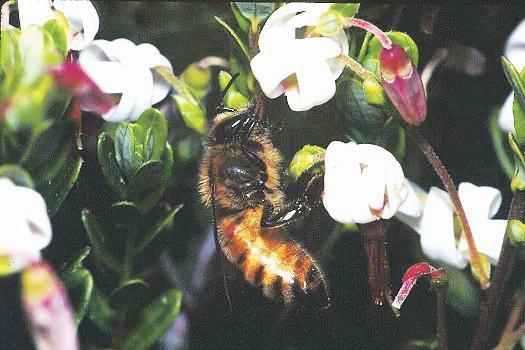
A very different example of the business of pollination comes from the cranberry industry. Cranberries are a native crop cultivated primarily in Wisconsin, Massachusetts, New Jersey, Oregon, and Washington. More than 39,000 acres (~15,800 hectares) of cranberries were harvested in the United States in 2005, a mere six percent of the total almond acreage in California’s Central Valley. Honey bees are not the most efficient bee in extracting pollen from a cranberry blossom (figure 1.5). But when the berries are grown over large acreages, they are the only pollinators with populations large enough to cover the entire crop. Bumble bees have longer tongues and because they can also buzz-pollinate, are much more efficient cranberry pollinators, on a flower-by-flower basis. It is difficult and very expensive, however, to obtain enough bumble bees to pollinate the crop.
Cranberries bloom in late June. This means that renting bees for cranberry pollination (as well as for pumpkin and other vine crops that blossom in midsummer) is usually at the expense of a honey crop the bees could make elsewhere from clover, alfalfa, and other wildflowers blooming at the same time.
A survey conducted by the Wisconsin Agricultural Statistics Service revealed that more than 17,000 acres (~6900 hectares) of cranberries were harvested in the state in 2005. That year, 76 percent of Wisconsin growers rented, on average, 1.8 honey bee colonies per acre (~4.5 colonies per hectare) at $50 per colony. Seven percent of the growers in 2005 rented honey bee colonies and purchased disposable bumble bee colonies, while six percent purchased only bumble bees. The survey also indicated that most cranberry growers had contracted the same beekeeper for an average of five years, and more than 72 percent were satisfied with the service. Just more than half of the colonies were inspected for colony strength that year, which means the grower trusted the beekeeper to rent them strong, populous colonies. It is not clear how many of the beekeepers signed pollination contracts to ensure payment.
The following is a first-hand example of the impact of honey bees and local native bees on cranberry pollination in Wisconsin. In 1999, a grower introduced 3 honey bee colonies per acre (7.4 colonies per hectare) onto his cranberry property. The next year, due to a market glut, the grower intentionally reduced his yield by not introducing honey bee colonies. Researcher Elaine Evans compared his yield in one particular bed with and without honey bees. With honey bees present, the individual cranberries weighed on average 0.056 ounces (1.6 grams), the normal weight of a well-pollinated cranberry. Without honey bees, the average cranberry weighed only 0.028 ounces (0.8 grams), half the weight. Yield is measured in biomass (barrels), so this grower certainly reached his goal to reduce yield.
Evans also observed honey bee and native bee visitation on these beds. The year honey bees were introduced by the grower mentioned above, she found 34 honey bees per ~1080 square feet (100 square meters). The next year, when the grower did not introduce honey bees, she found zero honey bees foraging on the cranberry flowers. She found one to three native bumble bees per 100 square meters, and a smaller number of halictids, megachilids and other bees both years whether honey bees were present or not, indicating that these native pollinators are in cranberry beds, just not in high numbers.
Previous research by Dr. Jim Cane showed that bees must deposit a minimum of eight pollen grain “tetrads” on the stigma of the flower for an individual cranberry blossom to set fruit. Did the cranberry bed with a few native bees but no honey bees receive sufficient numbers of these pollen tetrads? During early and late bloom, when few blossoms were open on each flower stalk (called an “upright”), the flowers did receive at least eight tetrads. But during mid-bloom, when the majority of flowers are open, only 50 percent received sufficient pollen.
The lesson to be learned from this story is that there are too few native, naturally present bees to ensure fruit set and good berry weight. Large acreages need honey bees, or a combination of honey and bumble bees, to ensure that all flowers receive enough pollen grains, especially during mid-bloom.
Natural areas provide nesting sites and forage for native bees. So, native bee populations will be more prevalent when natural areas surround the cranberry property—or any cropland. When cropland is surrounded by agricultural or disturbed land, native bees have fewer nesting sites. Also, honey bees may prefer to forage on the disturbed land, especially if flowers there yield more nectar and pollen or if the bees are introduced before the crop blooms. All crops and locations are not equal: timing is important, knowledge key.
